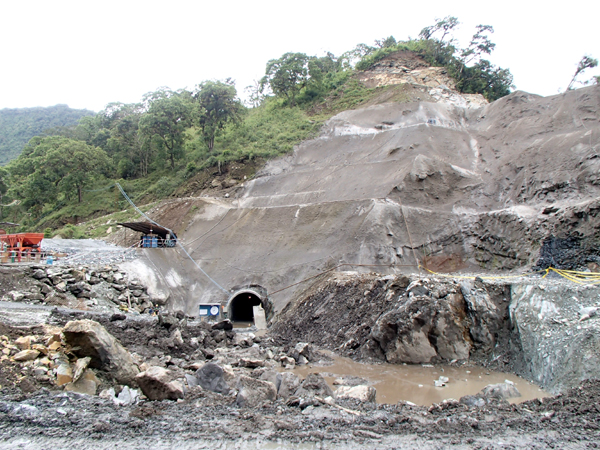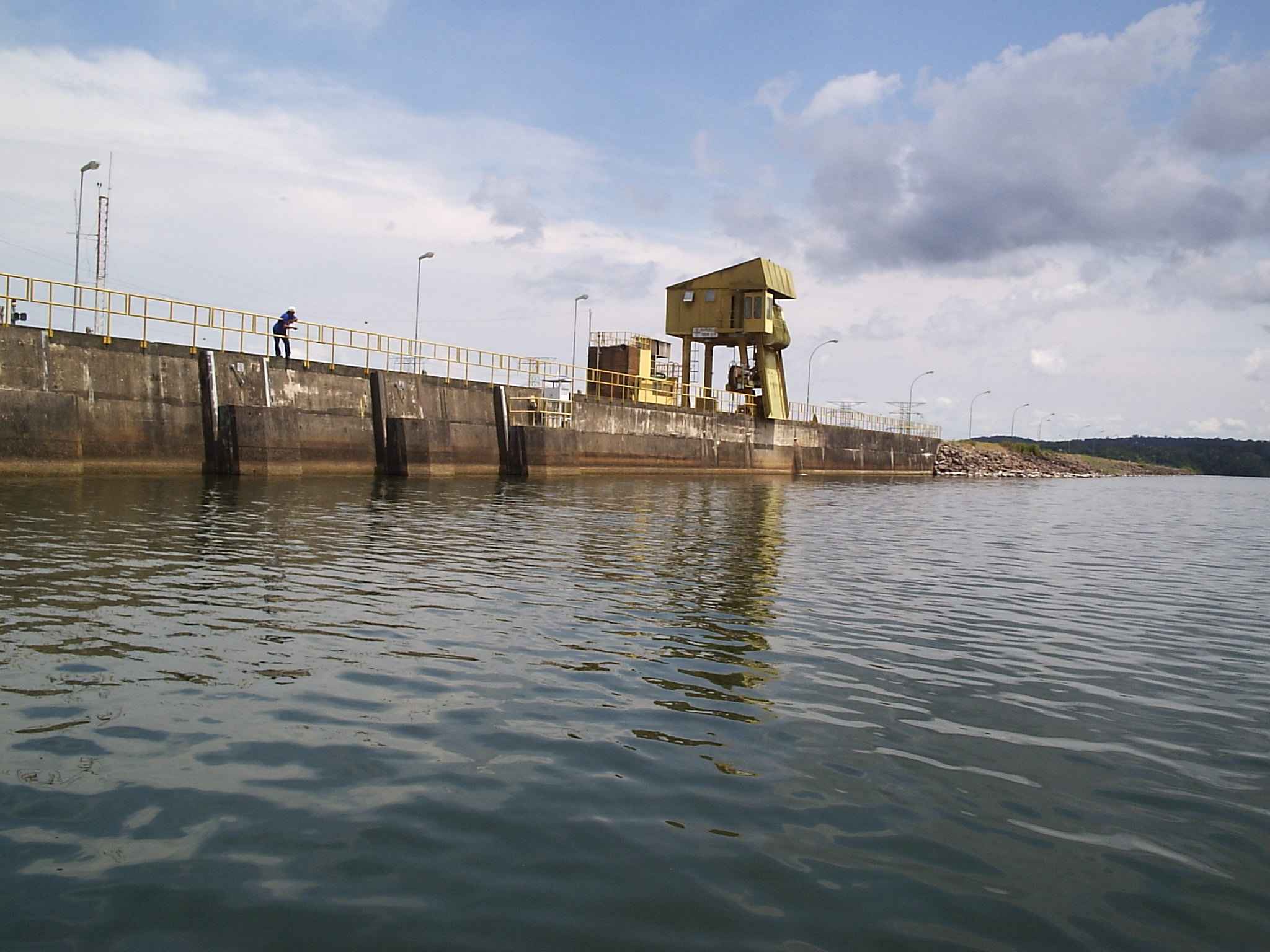Fed by snow from the glaciated volcanic peaks of the Andes Mountains, and by rainwater falling on steamy lowland Ecuadorian rainforests, this vast stretch of Amazonia supports diverse terrestrial and aquatic ecosystems, with significant unstudied flora and fauna.
At present, the main stem of the Napo River and most of its tributaries are free-flowing, with just two small 10 megawatt (MW) dams located on minor streams. That is all about to change, in a very big way, and the future of one of the last major free-flowing tributaries of the Amazon is at stake.
There are currently hydroelectric projects either proposed or under construction on nearly every tributary within the Napo watershed. In a 2012 paper, Finer and Jenkins reported that 19 dams were planned, including four large and two mega dams, one of which is the largest dam slated for the Ecuadorian Amazon, Coca Codo Sinclair. Only one of the Napo dams, Mazan, is outside Ecuador.

Many ecologists are concerned by the plans for massive development. “Considering that the Napo River is one of the sixth largest Andean tributaries of the Amazon, altering its flood pulse dynamics and hydrological connectivity would affect not only one of the best preserved river systems in the basin, but also many of the ecosystems and species downstream, and the ecosystem services that they provide,” Jorge Celi told mongabay.com. Celi evaluates environmental impact assessments and Biodiversity Offsets for the Wildlife Conservation Society. He has been studying the Napo River since 2007.
With dams already being built or planned on other large Andean Amazon tributaries, such as the Madeira River and the Marañon River, projects like those intended for the Napo and other major Amazon tributaries “should be avoided,” said Celi.
The harm of headwaters dams
Well-planned hydroelectric projects can provide excellent, local, renewable energy sources. However, the unchecked proliferation of dams in the Andean Amazon region is of great concern to many scientists and conservationists due to potential environmental impacts including disruptions to free-flowing river connectivity, loss of biodiversity, deforestation, and ecosystem fragmentation.

Each of the Andean Amazon tributaries is a unique system with unique diversity patterns. However, those rivers are also part of a bigger, more complex pattern of ecosystem functionality. “Losing or damaging the connectivity between these systems and the main stem of the Amazon is like cutting veins or creating clots in a circulatory system,” Dr. Jorge Celi, a specialist who has studied aquatic ecosystems in the Napo River basin since 1992, told Mongabay. With enough blockages, eventually the entire system fails.
Amazonia is home to approximately 10 percent of all freshwater fish species in the world – roughly 1,500 species. “Considering this extreme level of concentration, especially in western drainages that originate in the Andes, changing flow regimes affect more [regional] species than they would anywhere else [on Earth],” said Kelly Swing, professor of environmental science at Universidad San Fransisco de Quito and director of the Tiputini Biodiversity Station.
“Many large Amazonian species, which are commercially important, must migrate great distances to complete their life cycles. The construction of dams anywhere along their routes impacts local economies as well as access to protein for many subsistence cultures,” Swing said.
Over 600 freshwater fish species have been identified in the Napo River watershed, and new species are discovered on each sampling trip, making the Napo one of the most biodiverse rivers in the world in terms of fish species in relation to river size.

“Disrupting the connectivity of the Napo River would isolate populations of an extremely diverse fish fauna and interfere with large scale fish migrations (that migrate from the estuary to the Andean headwaters for reproduction) and lower the genetic exchange of rare and threatened species like the pink river dolphin. Most of the animal protein of local inhabitants comes from fisheries that depend on this hydrological connectivity,” Celi told mongabay.com.
NAPO WATERSHED DAMS CURRENTLY UNDER CONSTRUCTION
Five hydroelectric projects are currently under construction in the Napo watershed:
The Victoria-Quijos, Quijos and Coca-Codo Sinclair hydropower projects are located in the Quijos River Valley, a world class paddle sports destination and a Napo River tributary. The Quijos becomes the Coca River, which joins the Napo about 100 kilometers (62 miles) below San Rafael Falls at the town of Francisco de Orellana (also known as “Coca”.
The Dúe project is on the Dúe tributary of the Aguarico River, which joins the Napo near the border with Peru. The Pusuno hydro project is on a direct tributary of the Napo River near Puerto Misahualli. Here’s a detailed rundown of each project:
The Coca Codo Sinclair Project:
The Coca Codo Sinclair (CCS) is the largest hydroelectric project in Ecuador and should be operating by 2018 with a 1,500 megawatt (MW) capacity. The dam is located in a seismically active area of notable geologic instability and volcanic risk, with active eruptions. Under normal operating conditions this project will dewater 60 kilometers (37 miles) of the Coca River, a world-class adventure tourism destination that boasts the largest waterfall in Ecuador, San Rafael Falls.

Ecuadorian Rivers Institute Executive Director Matt Terry notes the dam’s problems: “The project is high cost, high risk, and over-dimensioned with respect to the available flow regime, and is located about as far away as possible from large population centers, and does not have an existing power transmission line.”
One way to minimize harm from dams is to develop them on rivers with existing hydroelectric projects, roads, and transmission line infrastructure. The CCS developers seem to have taken the opposite approach: Their project is being built in a roadless area, without transmission lines, far from population centers. The dam will require major new roads and extensive transmission lines to bring electricity to distant urban markets. Part of the new transmission line corridor will travel through an isolated roadless area, a natural heritage and biodiversity hotspot within the UNESCO Sumaco Biosphere Reserve.
“SINOHYDRO is building the CCS hydro project (diversion dam-tunnel-powerhouse) for the state-owned Coca Sinclair EP hydroelectric company, but the transmission lines were not included in the project studies or designs,” said Matt Terry. “The Chinese company Harbin Engineering was awarded an additional contract to build two, 500 kilovolt (kV), extra-high tension electric transmission lines to connect the CCS project to the nearest substation near Quito.” Each 500 kV transmission line needs a 60 meter-wide right-of-way, with new roads built to service them. “The transmission line was poorly planned, without stakeholder participation, and routed through protected areas to minimize the need to pay out compensations to private land owners,” Terry said.
The Quijos Project:
The 50 MW Quijos project includes a diversion dam, which will block both the Papallacta and the Quijos Rivers near the community of Cuyuja. Under normal operation, all water will be diverted from these rivers through tunnels, which will join into a unified penstock connected to the powerhouse located at the confluence of the two waterways.

“This project will eliminate recreational use and tourism in the famed Papallacta River Gorge,” Terry explained. “However, the project is establishing a new road accessing the upper section of the Quijos River, which could open up a new section of river of great interest to the paddling community. The builder has not made any provisions to consider recreational use or tourism in its environmental flow regime or operation, which adds to the losing character of its proposition.”
The Quijos project includes the construction of a 138 kV power transmission line, which will run all the way to the main substation in Quito. This, despite the fact that the two 500 kV CCS project extra-high tension power transmission lines will pass near the Quijos powerhouse and substation, making the 138kV line redundant.
The Dúe Project:
The 49.5 MW Dúe project consists of an antiquated, river-wide diversion dam across the Dúe River. The dam diverts most of the river’s flow through a tunnel to a powerhouse located about 10 kilometers (6 miles) downstream, leaving little or no flow in a section of river now used for recreation and tourism, as well as subsistence fishing by native indigenous communities.

“The Dúe Hydroelectric project is somewhat of a quandary,” said Matt Terry. “The Dúe River drains off the back-side of the Reventador Volcano, one of the most active volcanoes in Ecuador, that is currently erupting. The project… will open new roads and a bridge across the Dúe River, which will eventually draw more people to settle in this high-risk area, which is also mostly within a designated protected area. The private developer reportedly has close ties to the Ecuadorian government and has received a number of incentives for investing in this project.”
The Dúe dam was also pushed forward by a consortium of government municipalities who want to use a portion of the water diverted for the hydro project as drinking water for approximately 100,000 inhabitants in the Sucumbios Province – people whose local surface water drainages and groundwater aquifers have been contaminated by oil development.
However, since the Dúe River drains an active volcano, its water quality has very high levels of metals and minerals, which will require extensive and costly treatment, and could lead to public health concerns, as well as issues regarding the long-term viability of the water supply for the local population. There’s also the susceptibility of the water supply to ongoing volcanic events. “After considering these observations, a prominent international finance institution rejected the application to provide a $20 million loan for the project earlier this year,” said Terry.
The Pusuno Project:
The Pusuno project is a series of 2 dams (26 MW and 21 MW capacity) that will purportedly dewater a direct tributary of the Napo River that flows from the Sumaco Napo-Galeras National Park.
According to Matt Terry, this stretch of river is a “high-quality, natural heritage resource with extraordinary value which is used for community-based ecotourism and adventure sports.” At least it will be, until the dam Pusuno dam is completed.
NAPO WATERSHED PROPOSED DAMS
In the 2012 Finer and Jenkins paper 10 of the 19 dams proposed for the Napo Watershed were classified as high impact. Mongabay.com has gathered information on some of these dams proposed for the area:
The Mazán Project:
The 540 MW Mazán project will provide renewable energy to the city of Iquitos, which is not connected to the Peruvian transmission grid and currently depends on thermal generating plants for its electricity.

“This costly and ambitious project would construct a river-wide dam across the Napo River about 80 kilometers (49 miles) above its confluence with the Amazon, disrupting ecological connectivity for the entire Napo watershed, threatening the subsistence fishing of native indigenous communities throughout the lower basin rivers, and opening up a new road access to prime forest reserves on the northern side of the Napo River,” reported Matt Terry.
The Mazan hydroelectric project (named after the Mazan River, a black water tributary of the Napo) would actually dam the main stem of the Napo River below its confluence with the Mazan River. It would divert approximately 85 percent of the river discharge through a canal into the Amazon River.
“Most importantly,” said Jorge Celi, this project would “largely affect the canal geomorphological dynamics, the flood regime of extensive floodplains and wetlands controlled by riverine inundation downstream of the dam and the confluence of the Napo with the Amazon River, and disrupt the connectivity of the river with tremendous impacts on biota, including many species of migratory fish and aquatic mammals, among other things.”
La Merced de Jondachi Project:
This hydropower project would disrupt the ecological connectivity of one of the last remaining high-quality, free-flowing watershed corridors in a critical transition zone in the UNESCO Sumaco Biosphere Reserve.
Additionally, it would eliminate recreational uses and tourism from one of the most important paddle sports destinations in Ecuador, which brings in over $1 million dollars to local economies. All of this in order to generate only 5 MW of hydroelectricity under normal operating conditions.

This project is currently suspended due to legal opposition from local stakeholders and river users. The Ecuadorian Rivers Institute proposes an alternative vision for the river’s future, making it part of the proposed Jondachi-Hollín-Misahuallí-Napo Ecological Corridor, which could be included in the federal government’s new strategic plan to make Ecuador a major low-impact adventure tourism destination. The initiative is being spearheaded by the Ministerio del Deporte and the Ministerio del Turismo.
Santiago Miño of Ecuador’s Ministerio de Turismo told mongabay,com that he and his agency support this eco-tourism vision: “It is in our interest to declare the Jondachi River as a major tourist area and therefore try to keep the river in its purest form,” he said. “This year, the Ministry of Tourism of Ecuador has decided to make ‘Adventure’ an important priority,” especially since a quarter of the tourists who come to Ecuador come to participate in outdoor adventure activities.
“The [La Merced de Jondachi] project is high cost and high risk;” said Terry. “It will not recover its investment, including the interest on the loan, during its useful lifetime. The project is oversized, and has various deficiencies, including inadequate and incomplete studies and designs.”
The Jondachi-Sardinas Project:
The state-owned thermal generating company CELEC EP, also known as Termopichincha, is completely un-phased by the legal opposition to La Merced de Jondachi (LMDJ). The company maintains its intention to build not only the LMDJ hydro project on the upper section of the Jondachi River, but also the Jondachi-Sardinas hydroelectric project on the middle section of the same river.

This they plan to do instead of pursuing other recommended projects in preferred sites on rivers that are of low natural resource quality, already contaminated, already developed, and close to larger population centers and existing transmission line infrastructure.
The Jondachi-Sardinas hydroelectric project would end recreational uses and tourism on the middle section of the Jondachi River which brings important economic benefits to local communities, and would disrupt the ecological connectivity of one of the last remaining high-quality, free-flowing watershed corridors in a critical transition zone between the Andes and Amazon. It would be a considerable loss in return for a mere 6 to 12 MWs of generating capacity.
The Baeza Project:
The 50 MW Baeza project is in the final phase of design, and would require construction of a diversion dam on the Quijos River just below the outflow of the Quijos hydropower project, and just below the confluence of the Papallacta and Quijos Rivers.
Nearly all stream flow would be diverted through an underground tunnel which would run alongside the north side of the Quijos River, effectively dewatering 2 prime sections of river near the town of Baeza – popular with whitewater paddlers from around the world. The Quijos River was the site of the World Rafting Championships in 2005.
Both the Quijos and the Baeza projects are located in an area with pronounced geologic instability and seismic activity, which threaten the integrity of these hydroelectric projects and make them high-risk investments.
The Chalupas and Langoa II Projects:
The Chalupas and Langoa II Projects would result in significant transcontinental water diversion for drinking water supply, irrigation and hydroelectricity generation for the central sierra valley.
They would both require the construction of new roads and infrastructure within a protected area, the Llanganates National Park, and allow major new development in an otherwise isolated and protected source watershed of the Napo main stem tributary to the Amazon.
Keep an eye on the water
Environmentalists argue that many of the 19 dams in the Napo Watershed are either unneeded or poorly planned. A far better, even ideal, strategy, they say, would be to build no dams on main stem Amazon tributaries, and designate and protect those streams as “free-flowing” waterways. Protected rivers under this plan would include the Marañon, Madeira, Putumayo, Ucayali and Napo rivers.
“Hydropower can be part of a sustainable energy future if designed and operated in a manner that avoids and minimizes impacts on vital river functions.” Jeff Opperman, Lead Scientist of The Nature Conservancy and of the Great Rivers Partnership Initiative told mongabay.com. “A scenario of dams located high in the [Andes Amazon] watershed and only on some of the tributaries might have the least amount of impact on the environment and still provide significant electricity benefits. The degree of the impact is very much a function of good siting and design.”

Kelly Swing warns that: “As we continue to commandeer natural resources all over the world, we expand into the last remaining wild areas. With each passing day, nature is left with far less than scant decades ago. The proportion that we can actually take for ourselves without having disastrous impacts on the very resources we wish to exploit is undefined, but all indications suggest that we are nearing that tipping point.”
As mega-hydropower plans move forward in the Napo Watershed, a watchful, informed, and involved public could become an important factor in shaping Ecuador’s hydroelectric projects to be not only economically viable and developmentally useful, but ecologically sound and sustainable.
– This report was originally published in Mongabay and is republished by an agreement to share content.





